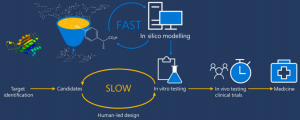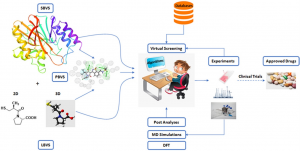Most Preclinical CROs provide studies that aim at providing information about safety and efficacy of a drug candidate before testing it in humans. Furthermore, they can provide evidence for the compound’s biological effect and usually include both in vitro and in vivo studies. Preclinical studies have to comply with the guidelines dictated by Good Laboratory Practice to ensure reliable results and are required by authorities such as the FDA before filing for approval as IND. Insights into the compound’s dosing and toxicity levels are essential to determine whether it is justified and reasonably safe to proceed with clinical studies and are provided by studies on pharmacokinetics, pharmacodynamics, and toxicology. (Honek, 2017)
Pharmocodynamics (what does the drug do to the body?). Pharmacodynamics describes the relationship between the concentration of a drug in the body and its biological effect (dose response). This includes addressing the question, how potent and efficacious the drug is with regard to its desired pharmacological effect, including safety aspects and AEs (adverse events). Thus, pharmacodynamics establishes the therapeutic index of a drug, describing the ratio of the dose causing toxicity and the dose eliciting a therapeutic effect. Ideally, the therapeutic index is large to indicate a wide therapeutic window.
Pharmacokinetics (what does the body do to the drug?). The effect of a drug is determined by the amount of active drug present in the body particularly at the target site. This, in turn, depends on absorption, distribution, metabolism, and excretion (ADME) of the compound. Pharmacokinetics describes changes in plasma concentrations over time as a consequence of ADME. ADME profiling is critical for establishing dose range and administration schedule for subsequent phases of the clinical trial.
Most drugs are administered orally and need to be absorbed in the gastrointestinal tract to enter the bloodstream, allowing them to be transported to their site of action. On its way to the target site, the drug reaches the liver, where first-pass metabolism takes place. Consequently, the drug concentration – and thus its bioavailability – is reduced before entering systemic circulation. Intravenous drug administration bypasses the first-pass effect, resulting in greater bioavailability. Once in the circulation, the drug is transported to different tissues. Distribution of the compound throughout the body is determined by (i) the drug’s affinity for plasma proteins, (ii) the drug’s molecular properties and polarity, and (iii) tissue vascularisation. After entering the body, drugs are metabolised to facilitate elimination. Metabolism refers to the chemical alteration of the parental drug into pharmacologically active or inert metabolites. To ensure adequate long term dosing and appropriate steady-state concentrations of the drug, it is critical to obtain information on drug elimination from the body (clearance). Clearance is mainly achieved via the renal and hepatic routes; however, pulmonary clearance plays a major role for volatile drugs such as anaesthetics. Concomitant disease, lifestyle factors, and patient’s age can affect clearance and these are frequently studied in later stages of the clinical trial. When the rate of clearance equals the rate of absorption, a so-called steady state is reached. Typically, maintaining a stable steady state level is desirable and can be achieved through repeated dosing. Eventually, the drug and its metabolites are excreted from the body mainly through urine or feces.
Toxicology (it is efficacious, but is it safe?). To determine whether a drug is safe for testing in human subjects, preclinical toxicology studies are performed to identify the treatment regimen associated with the least degree of toxicity and thus determine a suitable and safe starting dose for clinical trials. Additionally, they can be used to establish biomarkers for monitoring potential AEs later. Starting with single-dose studies to identify organs that might be subject to drug toxicity, preclinical in vivo studies continue with repeated-dose approaches. The treatment regimen ideally mimics the intended clinical
design with respect to treatment duration, schedule, and route of administration. Other studies evaluate carcinogenicity, genotoxicity, and reproductive toxicity. While the drug’s genotoxic effect is usually studied based on its potential to induce mutations in yeast-based in vitro systems, carcinogenicity and reproductive toxicity studies typically involve rats. As the tumorigenic effect of a drug may only become evident after prolonged exposure, carcinogenicity studies comprise continuous drug administration for a minimum of six months.
In vitro models (studying the drug in a petri dish). In vitro studies are a relatively fast, simple, and cost-efficient way of preclinical testing. Those studies utilize cell, tissue, and organ cultures, or focus on particular cell components such as proteins or other biological macromolecules. In vitro studies permit tight control and monitoring of experimental settings and often provide mechanistic evidence for the investigational compound’s mode of action. While having the potential to provide mechanistic insights, in vitro models are constrained by the fact that isolated cells may not behave in a petri dish as they would within the body where they partake in crosstalk and interaction with millions of other cells. Consequently, more sophisticated preclinical models are required to establish the investigational compound’s safety profile before transitioning to a clinical setting.
In vivo models (is the mouse the best experimental animal?). In vivo studies consider the complete organism based on various animal models. The choice of appropriate animal models depends on myriad criteria and requires understanding of species-specific physiology and similarity with regard to the target organ, metabolic pathways as well as financial, regulatory, and ethical considerations. Typically, in vivo studies are performed in a rodent (e.g, mouse, guinea pig, hamster) and non-rodent model to comply with FDA requirements. Mice, rats, and dogs are among the most frequently used animal models while testing in primates (e.g., monkeys, apes, etc.) is performed occasionally and typically for larger molecules.





